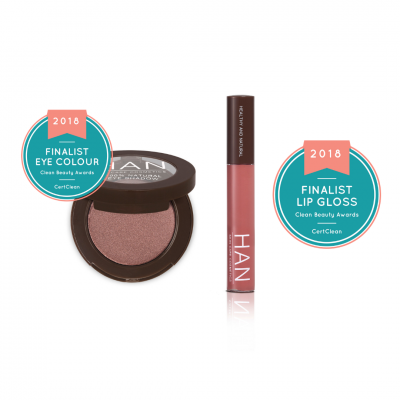As a clean and green beauty brand, HAN aims to prioritize our beautiful planet as much as our health and families. We work to ensure that our packaging is the best choice for our planet and products.
One major consideration all green beauty brands run into is whether to use plastic or glass packaging. After thoughtful deliberation, which includes considering greenhouse gas emissions in manufacturing and transportation as well as recyclability, cost and compatibility, HAN has found that plastic is the better choice for our products.
The impact of plastic and glass on the environment differs as early as when basic materials are drilled and harvested.
Environmental damage during harvesting
Plastic begins as oil and natural gases from the earth’s crust underneath layers of bedrock and requires drilling to reach. These raw materials are converted into monomers and bonded together to create polymers, the building blocks of plastic. The petroleum that plastics are made of are unfortunately non-renewable resources.
Glass, on the other hand, is created from liquefied sand, sodium carbonate, limestone, other recycled glass and various additives. The limestone in glass is necessary to ensure that the final, cooled glass retains its shape, but the mining of limestone also has its drawbacks. Water contamination, noise pollution, permanent landscape scarring and destroyed wildlife habitats are all consequences of limestone mining.
Environmental impact during production
The process to produce plastic begins with distilling crude oil to separate the oil out. The next step is to link monomers (smaller building blocks of petrochemicals) together into a chain. Because plastics are lighter than glass, during production, they require fewer raw materials and emit fewer greenhouse gases for the same amount of packaging.
Glass, on the other hand, is created when the raw material is heated and cooled rapidly. Because of this process, glass takes twice as much energy to produce than plastic and uses high amounts of fossil fuels to attain the high temperatures that make the formation of glass possible.
Considerations during transportation
The biggest factors affecting environmental impact are weight and size. Glass takes up more space because it is fragile and can’t be packed as tightly as plastic, resulting in glass materials being distributed in more boxes and shipments and needing extra packaging. Due to its heavier weight, glass also uses more energy, oil and gas to transport the same amount of material, resulting in a larger carbon footprint. From an economic standpoint, the additional costs to package and ship glass is always more expensive than plastic, often more considerably so.
The conclusion isn’t necessarily that glass is always the worse of the two materials to transport, but with current transportation methods and pathways, transporting glass is more costly environmentally and economically. When glass is transported by hand or shorter distances, the environmental impact of transportation decreases to become more comparable to plastic.
Reusing and recycling
Reusing glass is safer than reusing plastic. Glass can be repurposed without the same risk of chemical leeching that plagues many plastics. Polypropylene (also known as PP), the plastics that HAN uses in our packaging components, is recyclable.
In addition to plastics not being able to be reused, an unfortunate statistic is the low rate of plastic recycling. In 2014, 9.5% of all plastic was recycled in 2014. The low rate of recycling plastics can also be attributed to the fact that many plastics are not even recyclable. The other 90.5% ended up in landfills or converted into energy. When in landfills, plastic can take up to 700 (ten lifetimes) to decompose. When plastic is recycled, it is downcycled, which means that it’s turned into lower quality products, but downcycling keeps plastics out of the environment.
In comparison, glass is 100% recyclable and can be turned back into glass products of equally high quality. Recycled glass can have a lower carbon footprint during manufacturing than newly-created glass as well, since recycled glass is already the correct consistency. As a result, furnaces don’t have to run at as high of a temperature.
Compatibility
One additional consideration beauty brands have to think about when considering packaging is compatibility with product formulas. At their foundation, makeup is a mixture of chemicals that might react with its packaging. Some products, like some gel-based formulas, have ingredients in their formulas that work best with glass packaging.
Terracycle
With the heavy environmental impact of shipping and manufacturing glass packaging, plastic makes more sense for the moment for HAN’s products. In an effort to reduce plastic waste, HAN has teamed up with TerraCycle, a recycling organization, to encourage HAN customers to send back their empties. For every 6 HAN empties, customers receive a free lip gloss or eyeshadow of their choice.
The choice of plastic versus glass is not easy, especially when considering raw materials, manufacturing and transportation, and it is a decision all industries from peanut butter and baby food to cosmetics grapple with. For the moment, plastic makes the most sense for HAN’s packaging after much deliberation over environmental impact, transportation cost, compatibility with formulas and recyclability. Of course, as manufacturing and transportation processes adapt and change, HAN is committed to revisiting this question to ensure that our products and packaging are the most sustainable choice.
Sources
https://www.washingtonpost.com/national/health-science/why-glass-jars-arent-necessarily-better-for-the-environment-than-plastic-ones/2014/06/23/2deecfd8-f56f-11e3-a606-946fd632f9f1_story.html?noredirect=on&utm_term=.3c15782ed3a9
https://www.studentbrands.co.za/news/university-student/glass-vs-plastic-better-environment/
https://livegreen.recyclebank.com/column/because-you-asked/should-i-choose-plastic-aluminum-or-glass-bottles
https://www.mnn.com/food/healthy-eating/blogs/glass-vs-plastic
https://www.theplasticbottlescompany.com/glass-plastic-better-environment/
https://www.canr.msu.edu/news/steel_glass_and_or_plastic_bottles_what_is_the_best_choice
https://www.drkarenslee.com/comparing-reusable-bottles-stainless-steel-glass-plastic/
https://earth911.com/living-well-being/recycled-beverage-containers/


